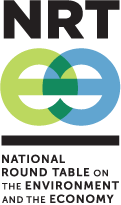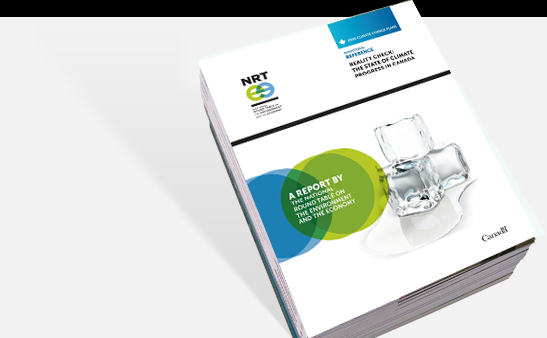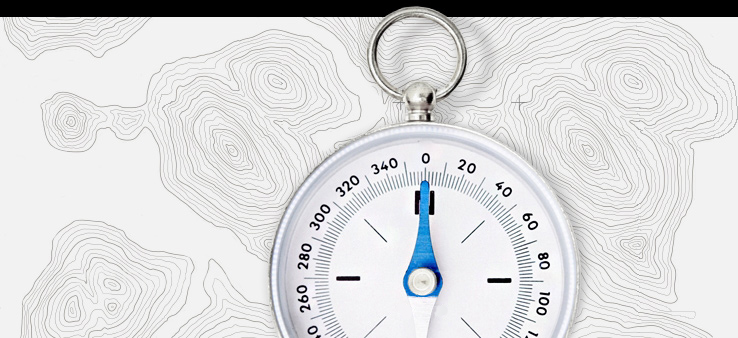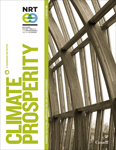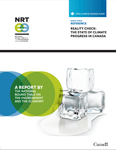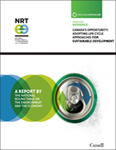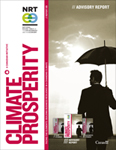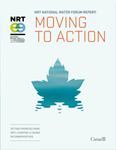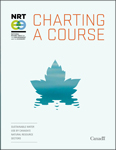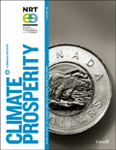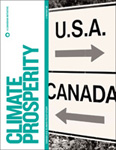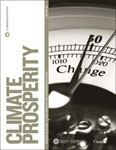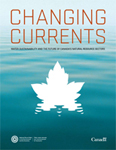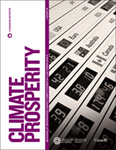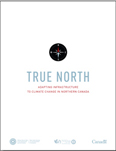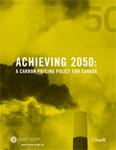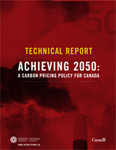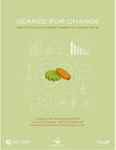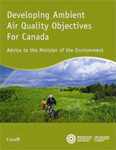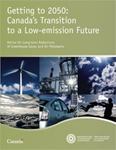Degrees of Change – Security and Trade
2.0 The NRTEE’s Degrees of Change diagram: Illustrating the Impacts of Climate Change in Canada
Security and Trade
| Previous | Table of Contents | Next |
This category focuses on security and trade to explore the implications for Canada of a warming world and responses to it outside our borders. Security is a value shared the world over. National security broadly refers to social, political, and economic stability of a country and its people, whereas human security centres on protection from fear and want, and empowerment for full participation in society. The exchange of goods and services with foreign markets through trade is a major feature of liberalized economies such as Canada’s. In 2008 alone, Canadian exports to our top three trading partners — the United States, the United Kingdom, and Japan — amounted to $396 billion.[191]
A changing climate is fast becoming a key lens through which to consider Canada’s place in the world, presenting both risks and opportunities. Climate change has risen to the agenda as a security issue in both international and Canadian fora. In 2007, for example, the United Nations Security Council discussed climate change as a potential driver of conflict around the world.[192] To mark its 20th anniversary, the NRTEE held high-level roundtable discussions in 2008 framing climate change as an issue of ecosystem security, energy security, and Arctic security.[193]
What we can expect
SECURITY ISSUES HEIGHTENED IN THE ARCTIC.
International issues regarding security and resource claims could arise or heighten with improved access to the region via marine routes and to resources underlying it.[194] Canada may well require further investments to protect its national security interests, such as safeguarding the Arctic marine environment, enforcing control and ownership over the Northwest Passage, and asserting our Arctic sovereignty overall with a more visible military and civil defence infrastructure.[195]
SHIFTING COMPARATIVE ADVANTAGE IN TRADE.
Canada’s comparative advantage in some products and services may improve in a world 1.5°C warmer than pre-industrial levels, as the impacts of climate change constrain other countries’ productive capacity.[196] Canada’s position in the production and trade of wheat and grains, for example, may improve relative to the rest of the world.[197] In regions where growing conditions become favourable, an increase in domestic production of fruit and vegetables could help satisfy demands and reduce reliance on imports. A changing climate could also contribute to a rise in global timber production (from increased forest growth), affecting global markets in the next few decades.[198] Benefits would likely go to consumers, as producers would see lower world prices and a reduction in Canada’s market share.[199]
INCREASING DEMAND FOR ASSISTANCE FOR AND RELIEF FROM CLIMATE-RELATED NATURAL DISASTERS.
The number of severe damage-causing storms worldwide has doubled over the last three decades, leading to a rise in property loss and affected populations, and a concurrent rise in Canadian assistance to disaster victims.[200] Compounded by a rise in people and property in at-risk locations, more frequent and intense extreme weather and climate events expected in the future are likely to increase global demand for disaster relief and assistance. Increased international assistance will be required, among other reasons, to secure access to safe water and food supplies in order to reduce deaths and illness due to diarrhoea and other diseases in post-disaster settings.[201] Canadians with businesses and property abroad could also place demands on disaster response services.[202]
INSTABILITY LINKED TO FOOD AND WATER SCARCITY.
More frequent and intense extreme weather and climate events distributed across the world pose risks to the basic elements of life such as food production, water access, and health, acting as threat multipliers in regions of the world already unstable or inducing instability in stable regions. [203] Outcomes of such instability and unrest include migration and conflict, increasing demands on immigration, global peacekeeping and diplomacy as well as Canadian resources to contribute through our armed forces, humanitarian aid and other official development assistance.
What we can do about it
As a rich country with well-developed governance structures, institutions, and positive global influence, Canada already has many of the mechanisms in place to help mitigate the security issues highlighted here and position itself to take advantage of any potential gains from a changing climate. Strategies to increase awareness, enhance monitoring and intelligence, and promote integration of climate change risks and opportunities into decisions in policies and programs pertaining to international trade, national defence, international assistance, disaster risk reduction, and immigration are all important. Canada’s Arctic Foreign Policy recognizes the effects of a changing climate on Arctic ecosystems and echoes the vision for the North as a “healthy, prosperous and secure region within a strong and sovereign Canada” previously outlined in Canada’s Northern Strategy.[204] Canada played an active role in developing OECD policy guidance on integrating climate change adaptation into development cooperation released in 2009.[205]
___________________
Footnotes
191 http://www40.statcan.gc.ca/l01/cst01/gblec02a-eng.htm Source: Statistics Canada, CANSIM, table (for fee) 228-0003. Accessed August 2, 2010
192 Security Council Holds First-Ever Debate on Impact of Climate Change on Peace, Security, Hearing Over 50 Speakers. United Nations (2007, April 17). Retrieved from http://www.un.org/News/Press/docs/2007/sc9000.doc.htm Accessed on November 2, 2010
193 A summary of NRTEE discussions is available at: http://www.nrt-trn.ca/eng/news-media/events/other/20th-anniversary/climate-forward/climate-forward-contents-eng.php
194 See Center for New American Security (2010), for example.
195 Charron (2005); Huebert (2005); Bruce and Haites (2008); Borgerson (2008).
196 Figure 2 (TS2) IPCC Working Group II Technical Summary, shows decreases at low latitudes and increases at mid to high latitudes of some cereal crops at about 1.5°C over pre-industrial levels (Parry et al. [2007]).
198 Given observed and projected range shifts of global terrestrial species and increasing risk from natural disturbances, changes in comparative advantage with respect to forest products could occur at relatively modest levels of global temperature rise relative to pre-industrial times.
199 Sohngen & Sedjo (2005); Perez-Garcia et al. (2002).
200 Bruce & Haites (2008); Mills (2005); Canadian Red Cross (2009).
202 Bruce Haites (2008) ; Mills (2005).
203 Barnett & Adger (2003); Bruce & Haites (2008); Smith et al. (2009). The positioning of this impact on the global temperature scale in the degrees of change diagram is taken from Smith et al.’s (2009) findings on risk of extreme weather events distributed across the world.
204 For more information on Canada’s Arctic Foreign Policy, see: http://www.international.gc.ca/polar-polaire/canada_arctic_foreign_policy_booklet-la_politique_etrangere_du_canada_pour_arctique_livret.aspx?lang=eng#environment. The Northern Strategy is available at http://www.northernstrategy.ca/index-eng.asp. The four priorities identified in the strategy are exercising our Arctic sovereignty; protecting our environmental heritage; promoting social and economic development; and, improving and devolving Northern governance.
205 The policy guidance document is available at http://www.oecd.org/dataoecd/0/9/43652123.pdf
